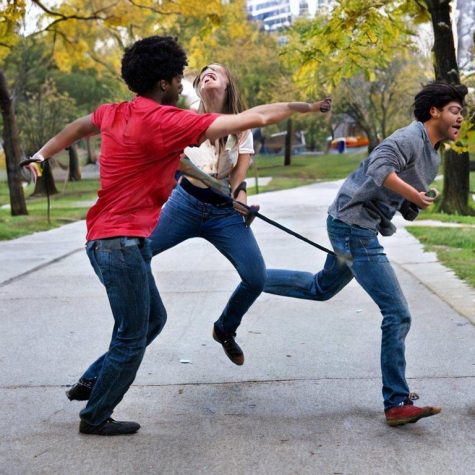A Case for Artificial Intelligence Image Generators
Some think AI imaging tools will take their jobs, others believe it will ruin art, and a select few are convinced they are haunted. Many are cautiously opposed to the use of AI in art-related applications. However, I believe they could be useful tools for artists, not necessarily as a final product but as a means to approach creative media ideas more easily.

Above is an image made entirely for free from the Stable Diffusion 2.1 Demo AI image generator. The image generator spits out a few generated images after the user enters a prompt. In the case of the above image, the prompt was “three college students dueling.” The image took one minute to generate. The image below also took one minute to generate, but I drew it. If one had a relatively short deadline to conceptualize a scene for a movie with dueling students, using an AI image generator would be a far easier way to go about it.

The efficiency and quality of AI image generators are hardly up for debate (ignoring their comedic difficulties with replicating human fingers). AI can do almost anything a human artist can in a fraction of the time. Of course, this is the problem most have with it. Human artists, real people making real art, will become obsolete. While logical at face value, this assertion could be expounded on.
The New York Times article, “An A.I.-Generated Picture Won an Art Prize. Artists Aren’t Happy.” by Kevin Roose from September of 2022 covers a man who won a digital art contest using AI-based image generators. Others in the contest and social media users were furious, claiming he had not done any work and essentially cheated by that virtue. Jason M. Allen, the contest winner, had spent hours and hours generating hundreds of images, trying to curate and fine-tune the perfect sequence of images. He then had to upscale them to be printed on canvas.
What about this is not art? Those who deny the merit in Allen’s project do not agree that he created art, as he did not have as much of a material hand in its creation compared to, say, an oil painter. The Merriam-Webster definition of art that I think best applies to this debate is, “the conscious use of skill and creative imagination, especially in the production of aesthetic objects”. Allen describes painstaking hours of attention to detail and creative direction as the driving factors in his creation. The AI-generated image was only half of the work. The value of AI is not for the final product, but for its ability to synthesize and forecast the images only an artist could creatively conceptualize. Despite the use of the AI-image-generating tool, Allen displayed a conscious use of skill and creative imagination to produce the aesthetic object.
Photography in its creation garnered similar pushback. Yet, photographers have cemented themselves as respected artists who simply harness different artistic attributes from other disciplines. This has been acknowledged by many artists who wish to explore AI-based image generators. They are more cautious with their applications of the technology and are trying to make it a standard to explicitly state when something was made with AI. This response is fair, especially when some are suggesting AI shouldn’t be used at all. Bitforms Gallery, which “represents established, mid-career, and emerging artists critically engaged with new technologies.” created an art exhibit that ran from October 26 to December 29 in 2022 to show off works that have been exclusively created with AI-based image generators.
It is not a stretch to say there was always a market for painting, drawing, or sculpture even after the invention of digital illustration or photography despite people also fearing those technologies would eliminate or diminish the previous mediums of artistic expression. Proper use of AI-based image generators opens doors to different kinds of creativity.
Fear of AI artwork is valid, but there is not enough behind it to in good faith say that it is going to lead to the destruction of art itself. These fears should be redirected at capitalistic forces which aestheticize and then monetize art to the point where it has lost its meaning. As demonstrated in Rian Johnson’s 2022 film Glass Onion: A Knives Out Mystery, the true destroyers of art are the bourgeois class that only values art for its capital and shallowly-derived aesthetic.
The battle should not be against AI artwork itself, but against those who do not consciously create. There is nothing inherently “anti-art” about AI-generated images. Real degradation of art occurs with corporate applications of artistry and mass-producing aesthetics, which they can do with or without AI.
https://thescarlet.org/wp-content/uploads/2023/07/scarlet-pdf-test.pdf




